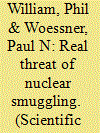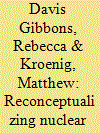| Srl | Item |
| 1 |
ID:
104795


|
|
|
|
|
| Publication |
2010.
|
| Summary/Abstract |
Our parents' generation grew up at a time of intense global instability, with two superpowers
madly competing to build the biggest, most ferocious nuclear arsenal, capable of destruction
on a scale beyond anybody's imagination. For progressive-minded people everywhere,
nuclear disarmament was the cause of the moment-one in which everybody, young and old,
had an equal stake. Thousands demonstrated in the streets to demand an end to the lunacy of
government policies and programmes that threatened to annihilate entire nations. In literature,
cinema, music and art, nuclear weapons featured prominently. Like climate change today, the
bomb was centre stage.
|
|
|
|
|
|
|
|
|
|
|
|
|
|
|
|
| 2 |
ID:
009853


|
|
|
|
|
| Publication |
Jan 1996.
|
| Description |
11-16
|
|
|
|
|
|
|
|
|
|
|
|
|
|
|
|
| 3 |
ID:
013313


|
|
|
|
|
| Publication |
Dec 1997.
|
| Description |
552-54
|
|
|
|
|
|
|
|
|
|
|
|
|
|
|
|
| 4 |
ID:
009638


|
|
|
|
|
| Publication |
Jan 1996.
|
| Description |
40-44
|
|
|
|
|
|
|
|
|
|
|
|
|
|
|
|
| 5 |
ID:
150112


|
|
|
|
|
| Summary/Abstract |
According to a widespread conventional wisdom in the scholarly literature, the threat of nuclear weapons resides largely in the risk of accident, inadvertent use, and nuclear terrorism. In this article, we argue that this conventional wisdom is inconsistent with the increasing danger of nuclear use by leaders intentionally employing nuclear weapons as tools of statecraft. This article identifies the theoretical processes that could give rise to deliberate nuclear use. Next, it marshals empirical evidence through an examination of developments in several salient geopolitical rivalries between nuclear-armed actors in the world today, demonstrating that deliberate nuclear use may be becoming increasingly likely. Finally, it offers concluding remarks regarding the steps world leaders can take to deter and prevent intentional nuclear strikes. This article seeks to bring back in an appreciation of deliberate nuclear use to academic studies of nuclear deterrence and instructs policymakers on the appropriate understanding of the risks of nuclear weapons proliferation.
|
|
|
|
|
|
|
|
|
|
|
|
|
|
|
|
| 6 |
ID:
019639


|
|
|
|
|
| Publication |
Spring 2001.
|
| Description |
24-35
|
|
|
|
|
|
|
|
|
|
|
|
|
|
|
|